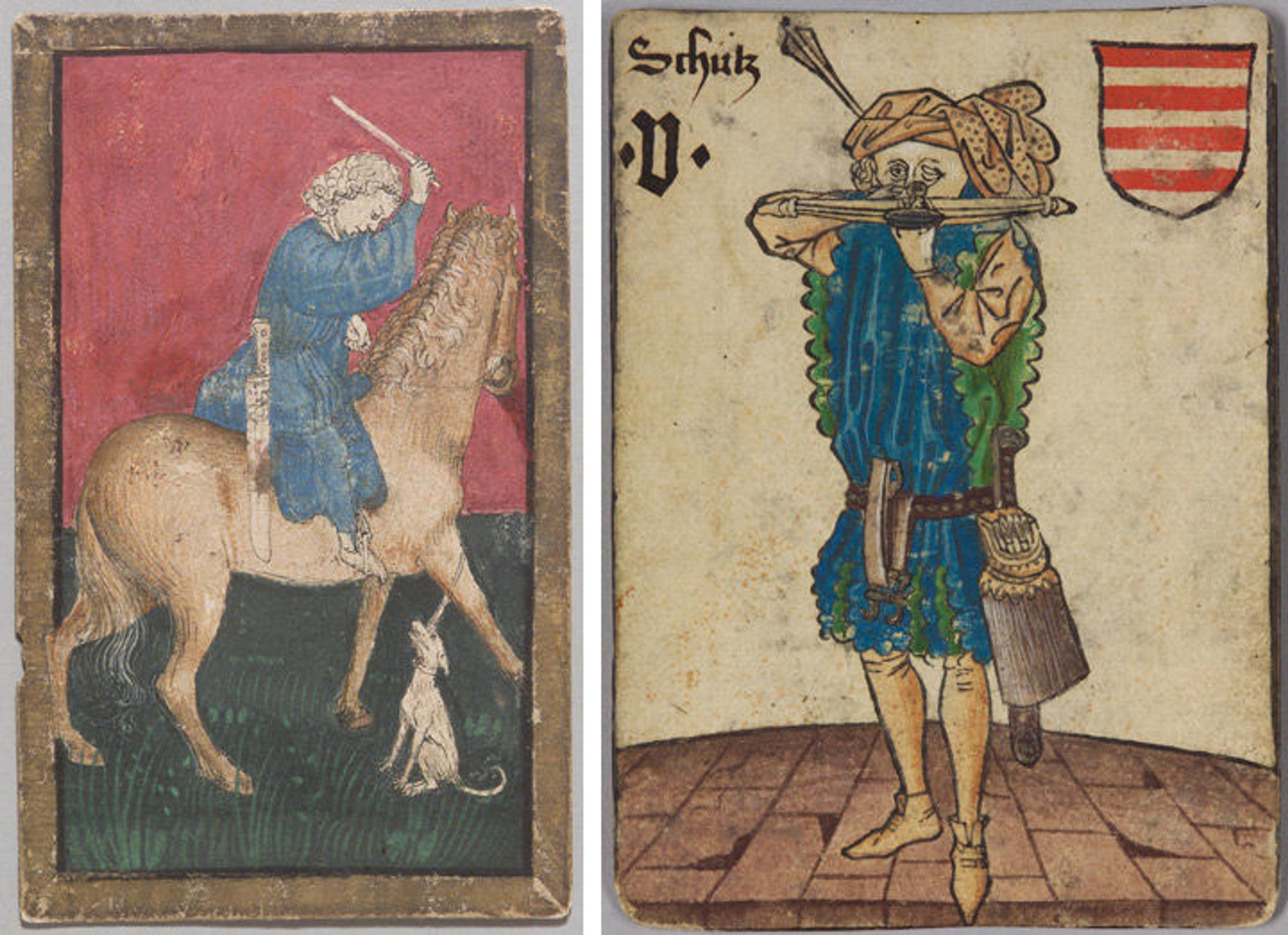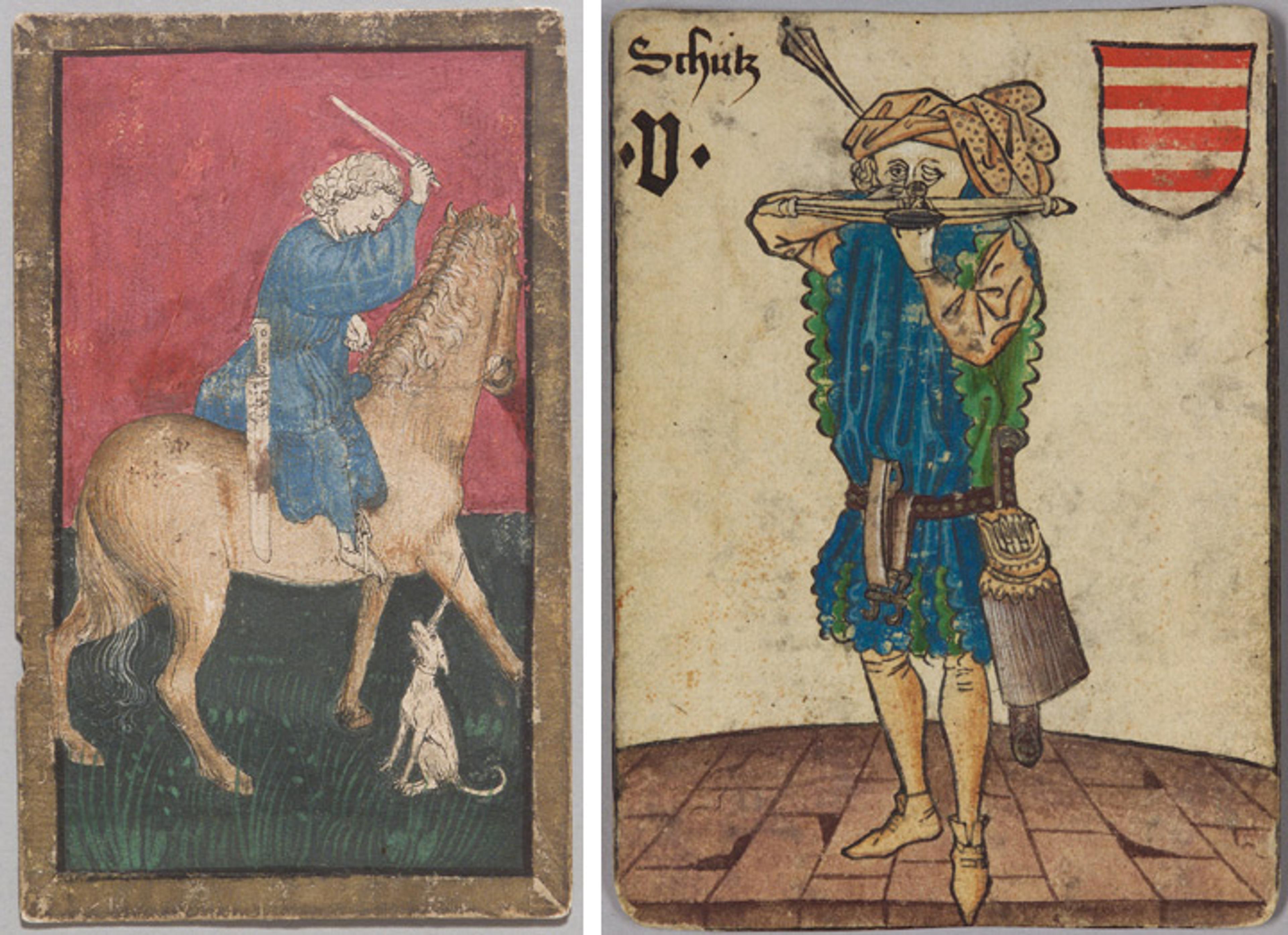
Left: Workshop of Konrad Witz (active in Basel, 1434–44). Under Knave of Hounds, from The Courtly Hunt Cards, ca. 1440–45. Made in Upper Rhineland, Germany. Paper (pasteboard) with watercolor, opaque paint, and gold over pen and ink; 6 1/4 x 3 7/8 in. (15.9 x 9.8 cm). Kunsthistorisches Museum Wien, Kunstkammer (KK 5036). Right: 5 (Crossbowman) of Hungary, from The Courtly Household Cards, ca. 1450. Made in Upper Rhineland, Germany. Woodcut on paper (pasteboard) with watercolor, opaque paint, pen and ink, and tooled gold and silver; 5 1/2 x 3 15/16 in. (14 x 10 cm). Kunsthistorisches Museum Wien, Kunstkammer
«At the center of the exhibition The World in Play: Luxury Cards, 1430–1540, on view through April 17, are two luxury decks of cards that once belonged to Archduke Ferdinand II of Austria (brother of Emperor Maximilian II) and were kept in the Kunstkammer he created at Schloß Ambras, near Innsbruck, sometime after 1567. Known as The Courtly Hunt Cards and The Courtly Household Cards, both decks were carefully described in Ferdinand's posthumous inventory, which also states that they were kept in special painted boxes, signifying the high regard in which they were held. Their fine and unsoiled condition indicates that they were valued for their artistry and were not intended for play.» In contrast, ordinary playing cards were small, unpretentious, and produced in large qualities with simple stamps or woodcuts with little, if any, color. Because they were discarded when soiled or worn, few have survived and only a handful are found in public collections.
The Courtly Hunt Cards
Largely based on style, The Courtly Hunt Cards have long been attributed to Konrad Witz, who was active in Basel between 1434 and 1444, and are thought to have been made late in his career, between around 1440 and 1445. The deck's four suits are Falcons, Herons, Hounds, and Lures, and each suit contains a king, queen, upper knave, and under knave, all on horseback, plus a banner (10) and 9 through 1. Because it has 56 cards rather than 48 or 52, this deck is considered unusual for German playing cards.
The cards are made of sheets of paper pasted together into stiff cardboard, but the bottom and somewhat larger sheet was wrapped over the front to make borders, which were subsequently colored gold. The images in the face cards were first drawn in pen and ink, and then flowers were scattered across the green turf and the backgrounds were painted. There are a number of highly finished horses, but some were left nearly or completely unfinished.
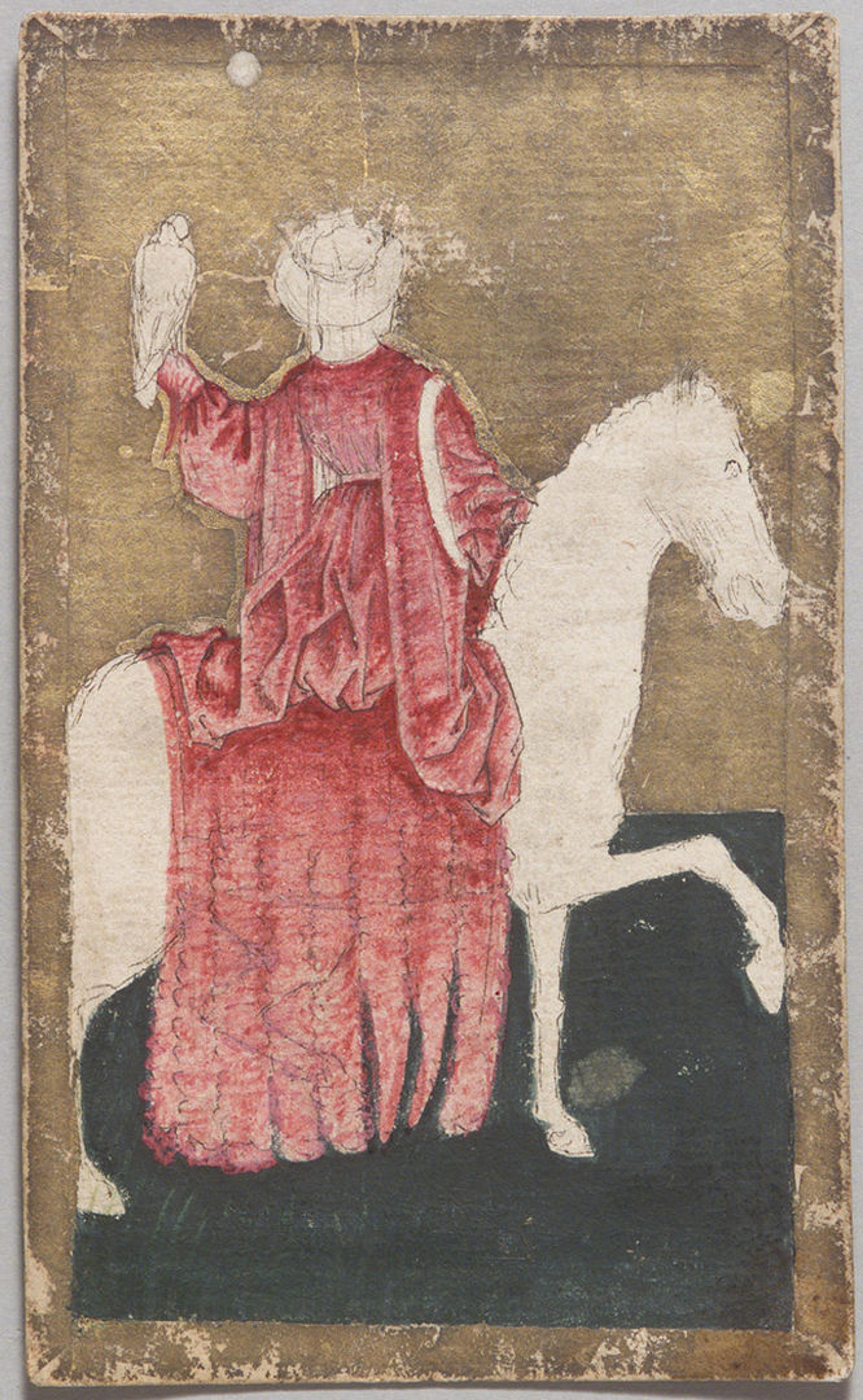
Workshop of Konrad Witz (active in Basel, 1434–44). Queen of Falcons, from The Courtly Hunt Cards, ca. 1440–45. Made in Upper Rhineland, Germany. Paper (pasteboard) with watercolor, opaque paint, and gold over pen and ink; 6 1/4 x 3 7/8 in. (15.9 x 9.8 cm). Kunsthistorisches Museum Wien, Kunstkammer
The suits symbols for Herons and Hounds are drawn with such expressiveness and control that they could be mistaken for finished drawings, but the light blue wash over the herons in some of the cards makes it clear that they were intended to be painted. Why many of the cards were left unfinished is not clear. The hands and faces may have been left for the master of the workshop, but, for whatever reasons, the cards were never completed.
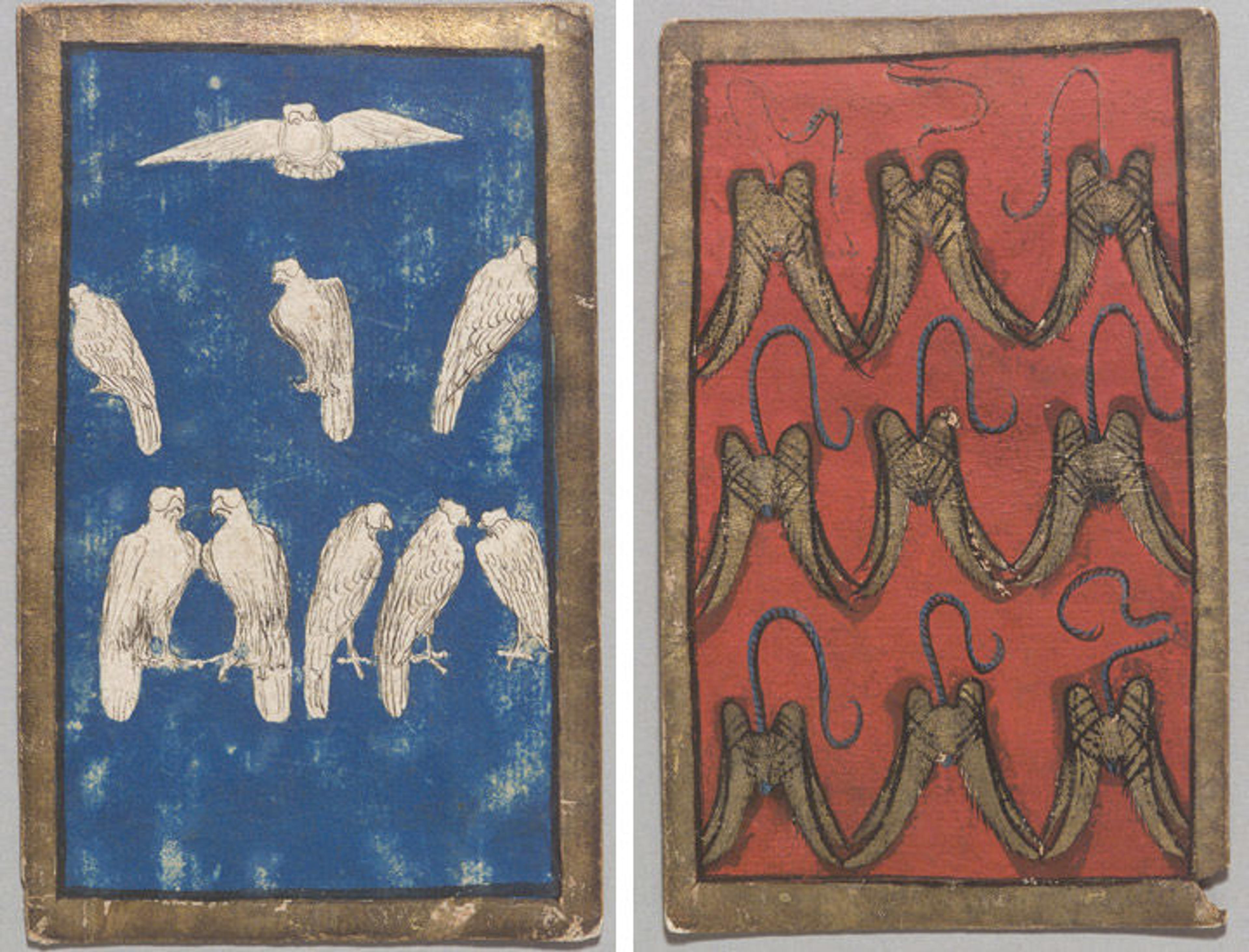
Left: 9 of Falcons, from The Courtly Hunt Cards. Kunsthistorisches Museum Wien, Kunstkammer. Right: 9 of Lures, from The Courtly Hunt Cards. Kunsthistorisches Museum Wien, Kunstkammer
In Herons and Hounds, the suit symbols are animals engaged in natural movement and activity. The Hounds—all set on a narrow foreground strip of greenery punctuated with leaves, blossoms, and blades of grass against a carnelian background—cavort together in such a variety of positions and activities that it makes a quick count difficult. In Herons, the water birds are in fully developed landscapes, some wading in rivers, others moving around on open greenswards. In some, a riverbank and a row of trees or reeds separate the foreground from the sky, which is a hazy, pale blue near the horizon that becomes a progressively deeper blue as it rises.

Left: 5 of Hounds, from The Courtly Hunt Cards. Kunsthistorisches Museum Wien, Kunstkammer. Right: 9 of Herons, from The Courtly Hunt Cards. Kunsthistorisches Museum Wien, Kunstkammer
The sensitive play of light brings atmospheric intensity to the exceptional landscape of the 5 of Herons, in which the limpid blue water in the foreground contrasts with the darker reflections of the rocky outcroppings on the placid surfaces of the broad river as it meanders into the distance, merging with the hazy, pale sky at the horizon. It is this expansive and luminous vision of the natural world, infused with a clarion light and harmonious beauty, that distinguishes the pip cards of Herons, a highlight of this exceptional deck.
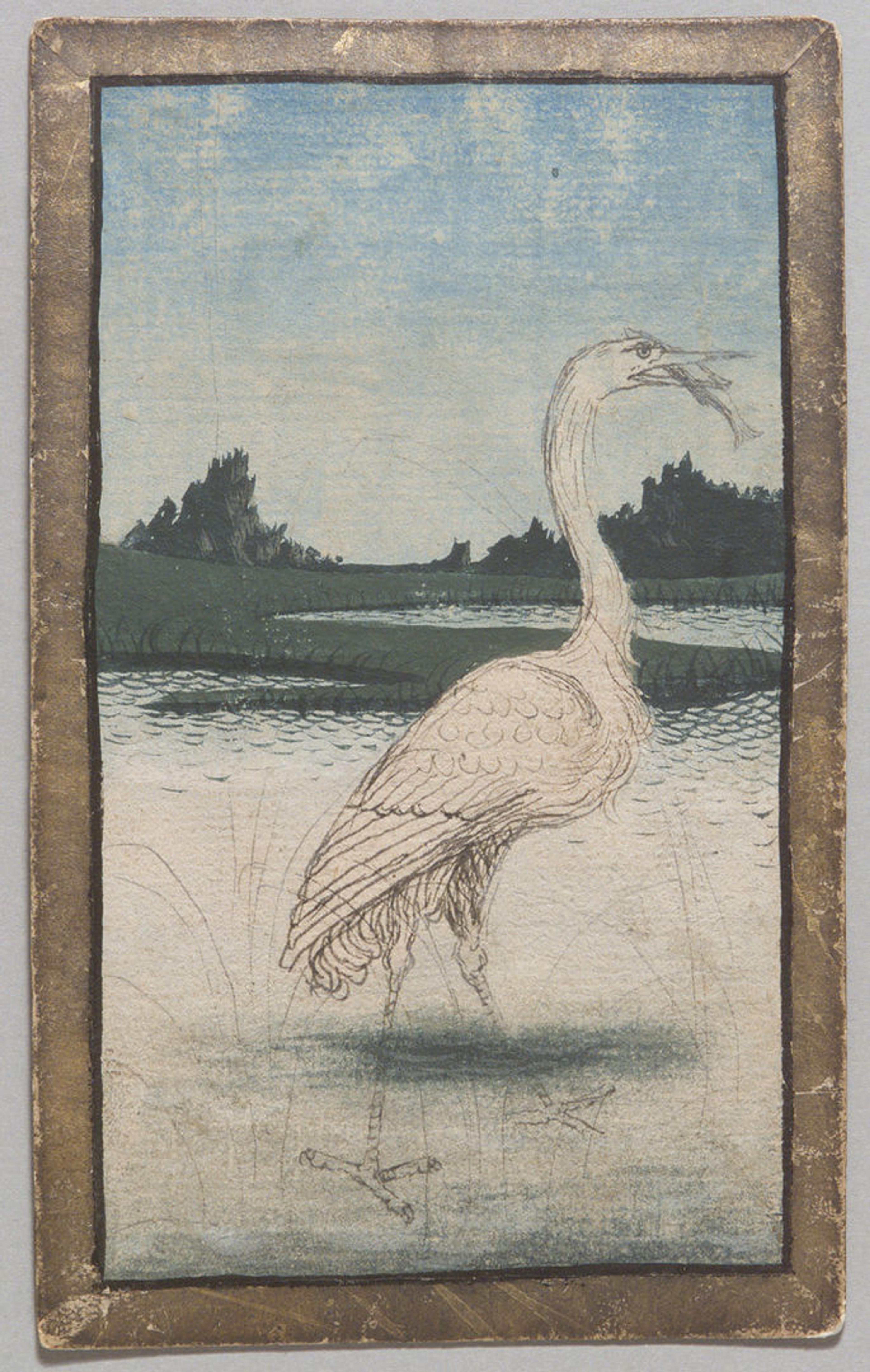
1 of Herons, from The Courtly Hunt Cards. Kunsthistorisches Museum Wien, Kunstkammer
The Courtly Household Cards
The structure of The Courtly Household Cards is loosely based on the hierarchy of officials and functionaries typically found in a late medieval princely court, from the highest ranks down through the lowest. The deck is composed of four suits: heraldic shields blazoned with the arms of the kingdoms of Germany, Bohemia, Hungary, and France. Each suit is led by a king and a queen, identifiable by their crowns and thrones, followed by a master of the household (10) and a marshal (9), with a fool (1) at the bottom—two male and two female. A young lady, or lady-in-waiting (6) appears in all four suits.
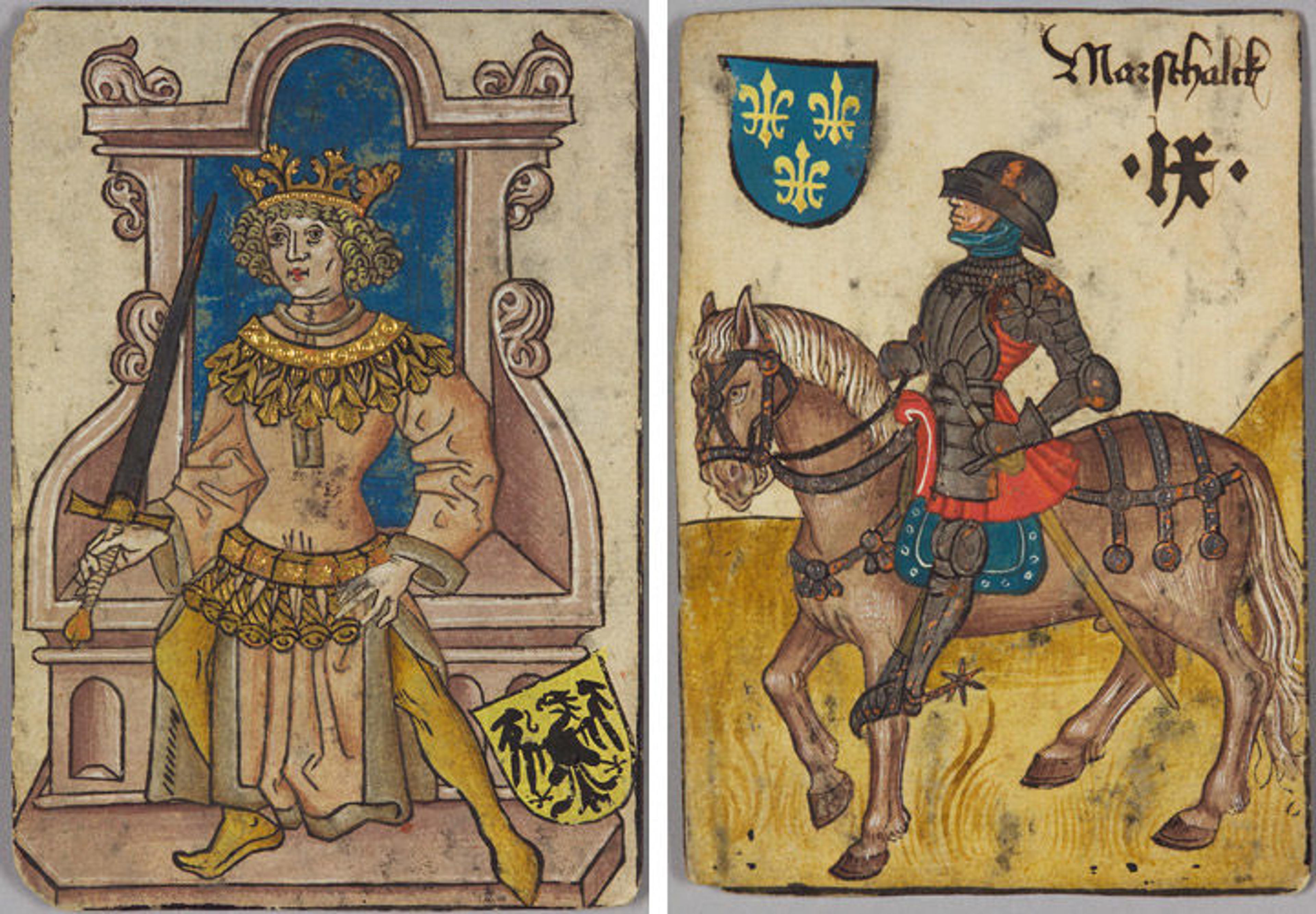
Left: King of Germany, from The Courtly Household Cards, ca. 1450. Made in Upper Rhineland, Germany. Woodcut on paper (pasteboard) with watercolor, opaque paint, pen and ink, and tooled gold and silver; 5 1/2 x 3 15/16 in. (14 x 10 cm). Kunsthistorisches Museum Wien, Kunstkammer (KK 5079). Right: 9 (Marshal) of France, from The Courtly Household Cards, ca. 1450. Made in Upper Rhineland, Germany. Woodcut on paper (pasteboard) with watercolor, opaque paint, pen and ink, and tooled gold and silver; 5 1/2 x 3 15/16 in. (14 x 10 cm). Kunsthistorisches Museum Wien, Kunstkammer (KK 5115)
Ranging from a medical doctor and a cupbearer, to a barber and a potter, the court functionaries or purveyors of descending ranks on the pip cards (8, 7, 5, 4, 3, and 2) are different in every suit (except the 4 of Bohemia and the 4 of Hungary, which are both mounted trumpeters). The cards, which constitute a complete deck of 48, were printed with woodblocks, mounted on pasteboard, and then colored with watercolor and opaque paint and enhanced with tooled gold and silver.
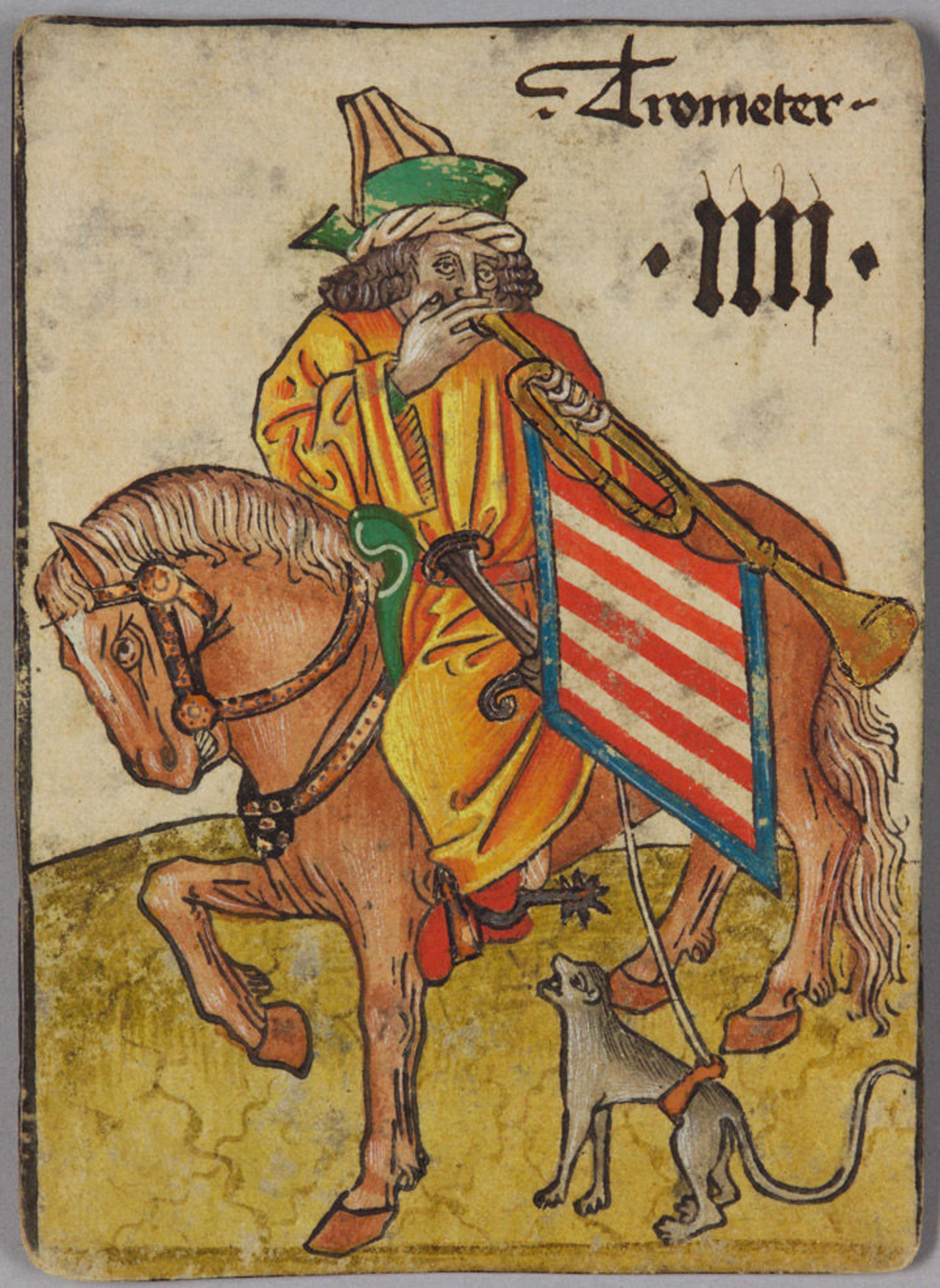
4 (Trumpeter) of Hungary, from The Courtly Household Cards. Kunsthistorisches Museum Wien, Kunstkammer (KK 5088)
The Courtly Household Cards are a unique compendium of secular woodblock prints of a quality unsurpassed at this early date. The lines are cut with such fineness and control that they could be mistaken for work in pen and ink. This is most pronounced in the detailing of the highly individualized faces, contouring of the outlines, and hook-shaped folds in the drapery.
The coloring of the figures and of their surrounds—a rarity in surviving early woodblock prints—is executed with a painterly refinement associated more with manuscript painting than with printmaking, as is most evident in the tonal gradations and the highlighting that defines sculptural volumes. The details of costumes, fabrics, and appurtenances are carefully rendered, and the decorative elements are lavishly picked out with gold and silver, often enhanced with punchwork that scatters reflected light.
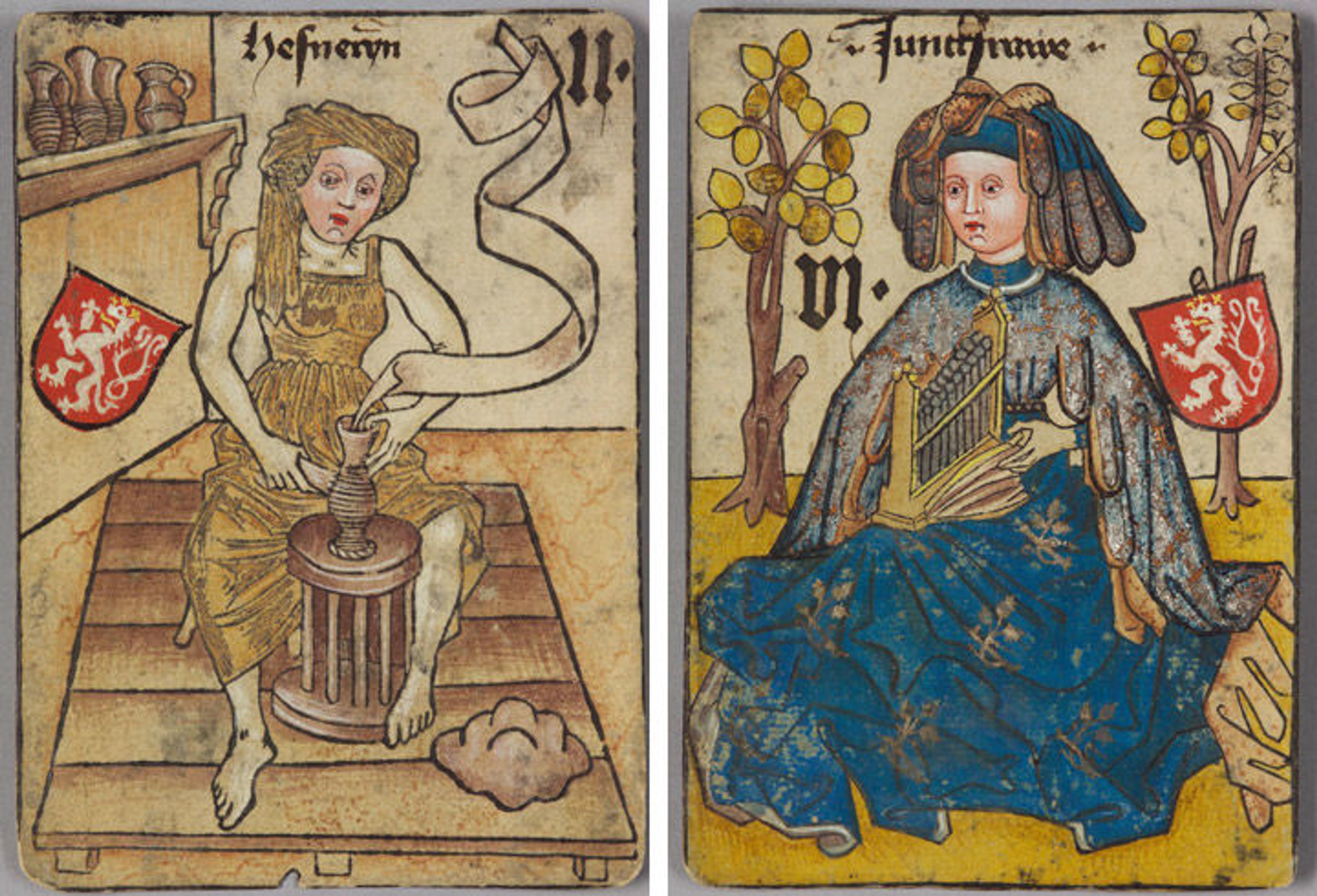
Left: 2 (Potter) of Bohemia, from The Courtly Household Cards. Kunsthistorisches Museum Wien, Kunstkammer. Right: 6 (Lady-in-Waiting) of Bohemia, from The Courtly Household Cards. Kunsthistorisches Museum Wien, Kunstkammer
The Courtly Household Cards are unique survivors, but written sources indicate the structure of this deck was not uncommon. In Das güldin Spil (The Golden Game), a series of sermons written in 1432, Master Ingold, a Dominican monk from Strasbourg, described a deck of cards based on a social order that seems akin to that of The Courtly Household Cards. The highest cards in that deck are kings, each with his coat of arms, followed by queens and ladies-in-waiting. The cards' suit symbols differed, but as in The Courtly Household Cards, the pip cards are individuals of varying social ranks. These cards could not trump the face cards, but they could trump one another in a topsy-turvy order. Thus, the moneylender trumps the nobleman, the priest the moneylender, the bawd the priest, the pimp the bawd, the innkeeper the pimp, the wine merchant the innkeeper, and so on. This upturned order cannot have pleased the authorities. Such decks of cards based on social strata, nonetheless, may well have been common for German playing cards before suit symbols related to the hunt were adopted.
Related Link
